Gold shines brighter than ever, leaving behind years of frustration for investors who bet on it.
For this reason, Russ Koesterich, director and portfolio manager at BlackRock, highlights that the current outlook is unbeatable for this precious metal, and points out that “gold’s stars continue to align.”
Many investors, including Koesterich himself, have experienced some disappointment with gold’s performance in 2021 and 2022. “Gold’s performance a few years ago is less surprising, given its mixed track record as a short-term inflation hedge,” says the analyst.
However, The current scenario has changed radically. “This year, gold is proving its value as a long-term reserve, especially in times of stratospheric government debt,” he notes.
One of the key factors that has pushed gold higher is the growing public debt from the United States, which currently exceeds 34.7 billion dollarsas seen in the following graph.
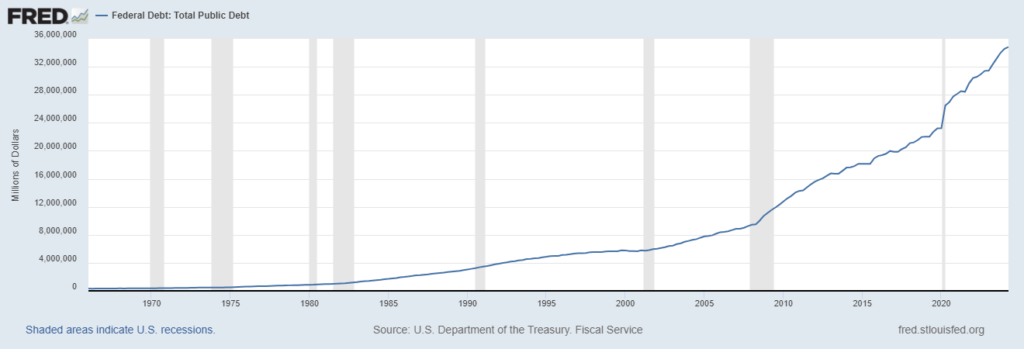

United States public debt. Source: FED.
This debt level is one of the highest in the world, with only Greece and Italy surpassing the United States in proportion to its GDP within the European Union.
Such a debt burden creates an unsustainable situation in the long term, making gold a safe haven for investors seeking stability.
Koesterich points out that the current context is unique:
«The last time I talked about gold was in mid-July. At the time, traditional macroeconomic factors, such as the trajectory of the dollar and real interest rates, were not supportive. However, long-term factors were starting to push gold up.”
Russ Koesterich, financial manager.
Since that date, gold has risen another 10%, and so far this year, the price of gold has increased by 32% reaching historical highs, as seen in the following graph of TradingView.
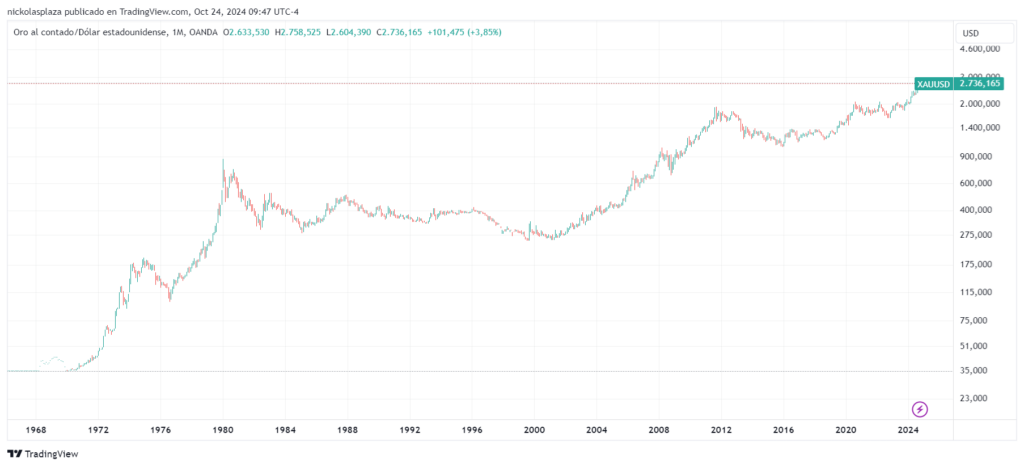

Gold price. Source: TradingView.
This performance far exceeds other investments, such as stocks and 60/40 portfolios (which invest 60% in stocks and 40% in bonds), making gold a very attractive investment in the current context.
Gold, an asset for times of uncertainty
This impressive rally makes gold a very attractive option in the current context.
“Any allocation to gold would have significantly improved the performance of virtually any multi-asset portfolio,” Koesterich emphasizes.
The recent rate cuts Interest rates by the Federal Reserve, such as 0.50% in September, have played a fundamental role in this increase in gold, breaking with the aggressive monetary policy that the Fed had maintained since March 2020, as seen in the following graph.
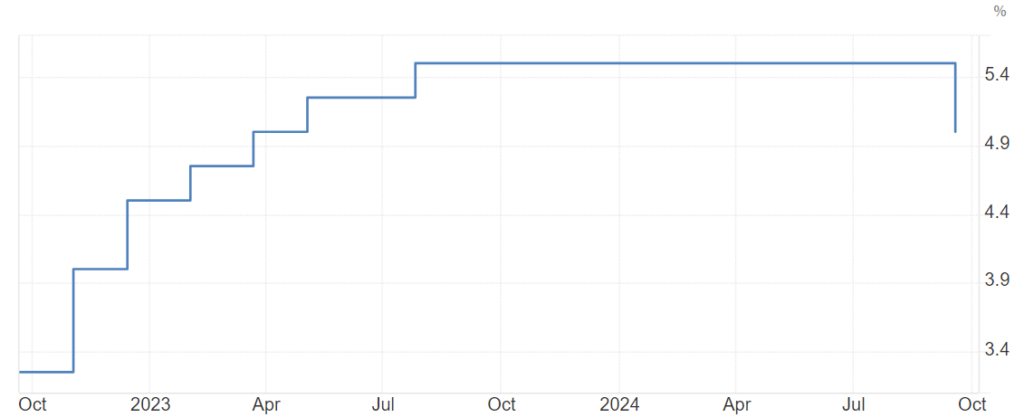

Interest rates in the United States. Source: Trading Economics.
Historically, Gold has been the safe haven asset par excellence in times of economic uncertaintyand its demand has risen as interest rates have fallen.
The outlook is so optimistic that even the Swiss bank UBS, which had raised its forecasts for gold at $2,750 per ounce by the end of 2024, saw this price reached much sooner than expected.
Looking to the future, Koesterich suggests including a modest allocation to gold, between 2% and 5% of the portfoliodue to a combination of favorable short-term economic factors and the permanence of long-term drivers.
Short-term factors: the dollar and interest rates
In the last six months, both the dollar and real interest rates have changed directiongoing from being unfavorable factors to becoming drivers of the price of gold.
The historically negative relationship between gold and the dollar has recently reaffirmed, meaning that as the dollar has weakened, gold has risen in price. In fact, the dollar index (DXY) It peaked in April but has since fallen 6%as seen in the following graph.
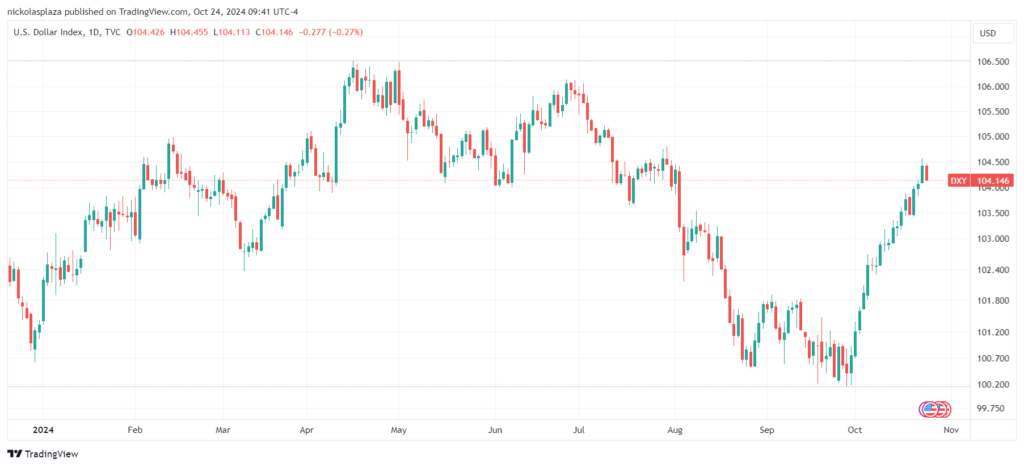

Dollar index. Source TradingView.
Meanwhile, real 10-year bond yields also peaked in April, standing around 2.2%. Today, those yields are 0.60% lower, at 1.60%, Koesterich explains.
This drop in real returns is crucial as it means that Investors are getting lower real returns on their bond investments.which increases the attractiveness of alternative assets such as gold.
For this reason, a new all-time high for the precious metal is not ruled out in the short term, as further rate cuts are expected in the near future, of up to a total of 100 basis points, which could be announced in the coming weeks. November and December meetings.
In this sense, Bank of America even estimates that gold could reach 3,000 dollars ounce by the first half of 2025, driven by macroeconomic uncertainty, high debt levels and continued purchases by central banks.
The long term remains promising
Koesterich also places emphasis on the long-term factors that continue to support gold. For example, central banks have continued to increase their reserves of this precious metal.
In the case of China, gold holdings are about 45% higher today than in 2022says the analyst. However, the Central Bank of the Asian nation has stopped buying gold for its reserves in the last 4 months, according to Reuters.
Beyond this, gold remains attractive to investors due to structural fiscal deficits in the United States, which are increasingly worsening with an annual budget deficit equivalent to 6-7% of GDP, he notes.
The gold industry also drives its price
Gold has not only strengthened in investment markets but has also given a significant boost to the Mining industry.
As reported by CriptoNoticias, the investment firm VanEck emphasizes that the increase in gold prices has improved the margins of mining companies, which has translated into greater cash flow, debt reduction and higher dividends for shareholders.
Besides, Current prices have encouraged exploration, allowing mining companies to finance new growth projects.
Koesterich concludes that, in this environment of economic uncertainty, growing debt and relaxed monetary policies, gold remains a sensible option.
«While it has been a great time, I think the price of gold can go higher. “I would recommend maintaining a modest position in gold as a reserve of value in times of uncertainty,” says the analyst.
Everything indicates that the gold stars are aligned, and this golden glow could continue to illuminate the markets for quite some time to come.
Bitcoin“>And what about bitcoin?
Having said all this, it is striking that bitcoin (BTC)which is described by its defenders as “digital gold” is not showing similar behavior.
Since March 2024, the currency created by Satoshi Nakamoto It does not set new historical highs.
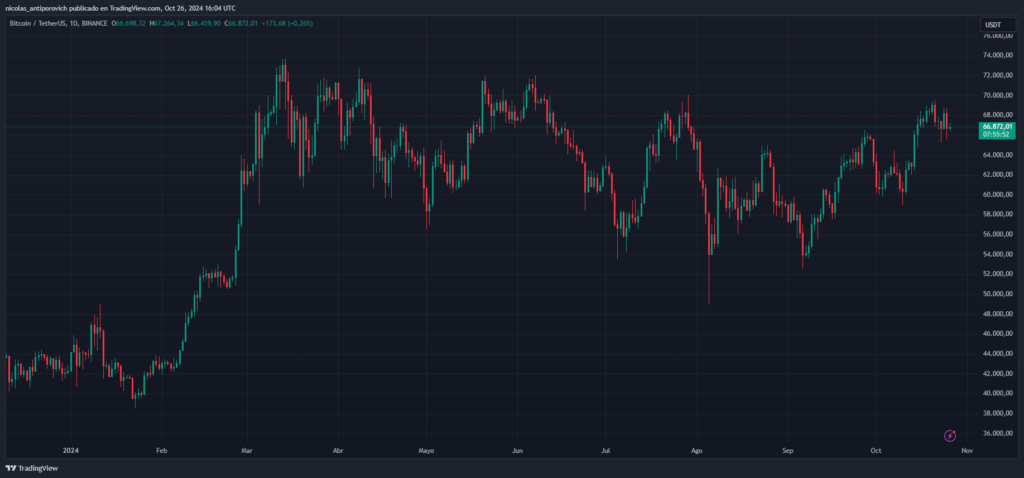

Bitcoin price since January 1, 2024. Source: TradingView.
What happens is that bitcoin, despite being known as “digital gold”, is still primarily perceived as a risk asset in financial markets.
The store of value narrative has yet to be definitively cemented in the minds of most traditional investors, who see it more as a speculative bet than a safe haven in times of uncertainty.
Such perception of bitcoin as a risk asset means that It’s early in your adoption cycle. and, therefore, offers an interesting opportunity for those looking to accumulate at relatively low prices.
From a negative perspective, this situation implies that the digital currency will continue to be vulnerable to volatility generated by macroeconomic factors, such as changes in interest rates and geopolitical tensions. However, from a positive perspective, it could be interpreted as the calm before the storm: a time to acquire bitcoin at prices that might one day seem ridiculously cheap.
As the “digital gold” narrative grows stronger, bitcoin has the potential to start behaving more like goldespecially in scenarios of economic crisis and expansive monetary policies.
Proponents of bitcoin argue that its properties, such as programmed scarcity (21 million coins), decentralization and resistance to censorship make it a more attractive option than gold for investors seeking a long-term store of value. However, bitcoin’s transition from a risk asset to a true global store of value is still in process.
The challenge for bitcoin is that it still depends on a favorable macroeconomic context to attract investment. When risk appetite wanes, as often happens in times of high inflation or crisis, bitcoin can suffer steep declines, unlike gold, which typically gains strength.
The future of bitcoin is tied to its ability to convince more investors that it is not just a speculation tool. If it manages to demonstrate its qualities as a store of value in the face of economic crises and monetary depreciation, it is likely that it will begin to behave less correlated with other risk assets and more in line with traditional safe havens, such as gold. When that happens, the upside potential will be significant, especially considering growing demand and limited supply.
Section “And what about bitcoin?” written by Nicholas Antiporovich.
Crypto Keynote USA
For the Latest Crypto News, Follow ©KeynoteUSA on Twitter Or Google News.






